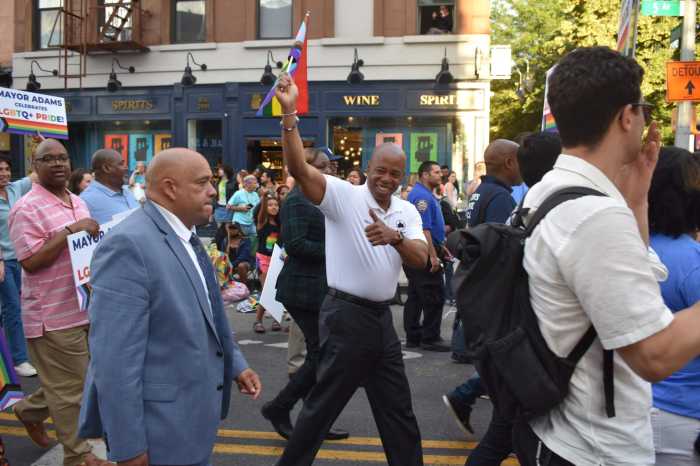Despite opening to the public back in April, Pier 64 celebrated its official coming out party on Thurs., Aug. 20, with a cadre of local advocates and elected officials on hand to fete the new waterfront mall that spent more than two decades in the making.
The group gathered at the end of the 500-foot pier between 24th and 26th Sts. to share memories of the Chelsea waterfront’s genesis through the years from all but forgotten to one of the most active stretches along the Hudson River.
Assemblymember Richard Gottfried credited a “relentless army of community organizers” with pushing for the revitalization of the West Side waterfront, which will also see two adjacent piers open next year along the Chelsea portion of the 5-mile Hudson River Park.
“This is as great an example of West Side vision and West Side activism as any one we have ever seen,” said City Council Speaker Christine Quinn of the local effort to create public passive space at the once bustling port.
The celebration was attended by State. Sen. Thomas Duane, Congressmember Jerrold Nadler, Manhattan Borough President Scott Stringer and Deputy Mayor for Economic Development Robert Lieber. Also joining were Connie Fishman, president of the Hudson River Park Trust; Robert Trentlyon, founder of the Chelsea Waterside Park Association; John Doswell, a founding chair of the Friends of Hudson River Park; Matthew Washington, deputy director of the Friends; and longtime community activists Ed Kirkland, Doris Corrigan and Lee Compton.
“I am really proud to be a part of this family,” said Stringer, a former Upper West Side representative on the state Assembly who previously worked with Gottfried on issues related to the Hudson River Park. “So many of you have really gone beyond the community organizer mold and have really created magic.”
Duane—who worked on waterfront issues as a community board member, district leader, city councilmember and state senator—praised the persistence of advocates in realizing their goal.
“We waited a long time, and it’s worth it,” he said of the project, adding, “it’s spectacular, it’s beautiful, it’s amazing. We should be very proud of ourselves.”
Many of the speakers, including Duane, reserved the highest praise for Trentlyon, who helped lead the charge to redevelop the Chelsea waterfront throughout the 1980s and ’90s.
“This is more than Hudson River Park adding another pier to the park,” Trentlyon said in his statements. “It’s about tearing down the wall that has kept Chelsea locked off from its waterfront for close to two centuries.”
He recounted the riverside’s evolution from economic engine serving the maritime industry to the traffic initiatives that included the West Side Highway and the High Line railway. But for most of that time, residents on the Lower West Side remained removed “from their rightful possession of the Hudson River,” Trentlyon noted.
“In fact, the lack of contact with the river made many Chelsea residents forget one of the great rivers of the world was just a few blocks away, or even forget they lived on an island,” he said.
But now—with the High Line reimagined as a popular public park and Pier 57 off 15th St. slated for redevelopment—“the wall has fallen down, and Chelsea residents are united with the Hudson River once again.”
































